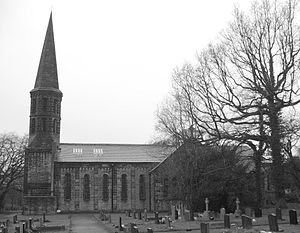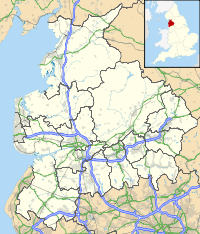- St Saviour's Church, Cuerden
-
St Saviour's Church, Cuerden
St Saviour's Church, Cuerden, from the northLocation in Lancashire Coordinates: 53°43′11″N 2°39′36″W / 53.7197°N 2.6600°W OS grid reference SD 565 250 Location Cuerden, Lancashire Country England Denomination Anglican Website St Saviour, Cuerden History Founded 28 July 1836 Consecrated 3 October 1837 Architecture Status Parish church Functional status Active Heritage designation Grade II Designated 27 February 1984 Architect(s) Edmund Sharpe, T. H. Myers Architectural type Church Style Romanesque Revival Groundbreaking 1836 Completed 1886 Specifications Materials Sandstone, slate roof with red ridge tiles Administration Parish St Saviour, Bamber Bridge Deanery Leyland Archdeaconry Blackburn Diocese Blackburn Province York Clergy Priest(s) Rev G Halsall Laity Reader D. J. Lord Churchwarden(s) P. J. Boyd, D. R. Pearson St Saviour's Church, Cuerden is in the village of Cuerden, Lancashire, England. It is an active Anglican parish church in the deanery of Leyland, the archdeaconry of Blackburn and the diocese of Blackburn.[1] The church has been designated by English Heritage as a Grade II listed building.[2]
Contents
History
The church was built in 1836–37 to a Romanesque design by the Lancaster architect Edmund Sharpe.[3] It was one of Sharpe's first commissions and one of his early churches in Romanesque style.[4] The church was paid for mainly by public subscription. The foundation stone was laid in 28 July 1836 by Robert Townley Parker of Cuerdon Hall, who gave the land for the church. It was consecrated on 3 October 1837 by the Bishop of Chester.[5]
In 1886, the chancel and transepts were added in a similar style by T. H. Myers.[3] The foundation stone for this extension was laid on 17 July 1886, and the church was re-consecrated on 10 February 1887 by the Bishop of Manchester.[5]
Architecture
St Saviour's is constructed in local sandstone, with a Welsh slate roof and red ridge tiles.[2][5] Its plan consists of a five-bay nave with transepts, and a chancel with a semicircular apse. At the west end is a tower consisting of a two-stage square base, a two-stage octagonal drum and a spire. Internally is a gallery supported on cast iron columns, decorated with the Royal coat of arms. On the walls are monuments to the Townley Parker family. The font dates from the early 20th century and consists of an octagonal bowl supported by angels and a bronze cover with a figure of St John the Baptist.[2][3] The two-manual organ was built in 1889 by Alexander Young.[6]
See also
- List of architectural works by Edmund Sharpe
References
- ^ St Saviour, Bamber Bridge, Church of England, http://www.achurchnearyou.com/bamber-bridge-st-saviour/, retrieved 15 March 2010
- ^ a b c "Church of St Saviour, Bamber Bridge", The National Heritage List for England (English Heritage), 2011, http://list.english-heritage.org.uk/resultsingle.aspx?uid=1074104, retrieved 13 May 2011
- ^ a b c Hartwell, Clare; Pevsner, Nikolaus (2009) [1969], Lancashire: North, The Buildings of England, New Haven and London: Yale University Press, p. 96, ISBN 978-0-300-12667-9
- ^ Price, James (1998), Sharpe, Paley and Austin: A Lancaster Architectural Practice 1836–1942, Lancaster: Centre for North-West Regional Studies, pp. 41, 67, ISBN 1-86220-054-8
- ^ a b c Hughes, John M. (2010), Edmund Sharpe: Man of Lancaster, John M. Hughes, pp. 116, 121
- ^ Lancashire, Bamber Bridge, St. Saviour (S00037), British Institute of Organ Studies, http://www.npor.org.uk/cgi-bin/Rsearch.cgi?Fn=Rsearch&rec_index=S00037, retrieved 25 July 2011
Categories:- Church of England churches in Lancashire
- Grade II listed churches
- Grade II listed buildings in Lancashire
- Romanesque Revival architecture in England
- Religious buildings completed in 1837
- 19th-century Anglican church buildings
- Buildings and structures completed in 1886
- Diocese of Blackburn
- Edmund Sharpe buildings
- Buildings and structures in Chorley
Wikimedia Foundation. 2010.


